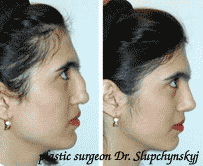Individuals of different races differ from one another in certain anatomical features. There are specific anatomical differences between the noses of nonwhites and those of whites. Even though, sometimes people want to gain features that are distinctive for another race, most usually individuals undergoing plastic surgery wish to improve their appearance by keeping their ethnical features. And hence, plastic surgeons should be aware of these racial differences and should use specific surgical techniques to gain desired aesthetic results.
The idea of multiracial rhinoplasty evolved in 1913 when Schultz published his work characterizing typical black nose. Many authors have pointed out that noses of non-whites are broad, flattened, with thick nasal skin and huge amount of subcutaneous tissue. However, these stereotypic characteristics differ in individuals. Even though individuals are of the same race, their noses may differ dramatically.
Ethnic rhinoplasty
Patients, who seek ethnic rhinoplasty procedure, usually want to improve their appearance by keeping their racial heritage characteristics. Candidates for this type of plastic surgery are those, who have characteristics of the nose typical for their race. People, who have noses with widened bases, thicker skin, flat bridge etc., may want to improve aforementioned features and gain more prominent nose by keeping in their ethnic group.
Differences in nasal anatomy
 African American nasal anatomy differs from others in skin thickness and abundant fibrofatty tissue. Nasal bridge consists of short bones, and is flat and wide. The tip of the nose is usually bulbous and of minimal definitions. The nostrils are flaring and horizontal. These are the features that individuals of African American decent want to correct but not change completely in order to keep their racial characteristics.
African American nasal anatomy differs from others in skin thickness and abundant fibrofatty tissue. Nasal bridge consists of short bones, and is flat and wide. The tip of the nose is usually bulbous and of minimal definitions. The nostrils are flaring and horizontal. These are the features that individuals of African American decent want to correct but not change completely in order to keep their racial characteristics.
Hispanic nose also has a thick skin with a wide bridge. Its tip is also bulbous, of minimal definition with abundant nasal soft tissue. The base of the Hispanic nose is wide, thick, with flaring and horizontal nostrils.
Asian nasal anatomy differs a bit more from the African American and Hispanic nasal anatomy. Skin of the Asian nose is thick and sebaceous, and also heavy. Its bridge is wide. The tip of the nose is bulbous, with thickened skin, abundant nasal soft tissue and of minimal definition. But both the doctor and the patient should understand the presence of individual varieties.
Best candidates for ethnic rhinoplasty
Who are the best candidates for ethnic rhinoplasty? Basically these are multiracial individuals, who want to improve their nasal appearance and preserve defining racial features. These patients should be in a good general condition, have no major physical or mental disorders which would limit the possibility of plastic surgery. Also, this individual should have realistic expectations for this procedure.
The incidence of ethnic rhinoplasty has increased during the recent years. Imptoved new surgical techniques and excellent technology as well as good advertising campaign made ethnic rhinoplasty procedure more favorable to multiracial patients. Since populations of multiracial immigrants are growing, the amount of multiracial individuals requesting for ethnic plastic surgery is increasing, especially in large centers of urbanization. In some places the doctor might have only nonwhite patients. Some surgeons only practice in ethnic plastic facial surgery.
Ethnic rhinoplasty surgery
The aims of ethnic rhinoplasty may vary from individual to individual, but there are some major points that in ethnic rhinoplasty. The surgeon aims to make the nasal bridge slightly thinner. Most of the multiracial patients wish to see their tip of the nose more refined, increased in rotation and projection. Since skin soft tissue is abundant in most non-white individuals, most doctors try to give the soft tissue slight thickness in order to provide excellent definition of the tip of the nose.
Ethnic rhinoplasty involves a few different surgical procedures to improve appearance or function. Septoplasty with or without Graft Harvesting is most usually used in patients with a curved nasal septum. Incisions and skeletonization is needed for primarily open technique. Nasal tip surgery is applied to achieve better appearance of the nasal tip. Other procedures include the following: osteotomies, harvest/placement of autologous and/or alloplastic grafts, and alar base reduction.
It is quite complicated to describe individuals, who request ethnic rhinoplasty . It is just as hard as to describe white people, who want to have facial plastic procedures. Younger multiracial individuals usually want to undergo facial plastic surgery to improve their appearance and to keep their ethnic characteristics. Older patients want to reverse effects by aging on their noses. However, there is a great deal of individual, who want to have their nasal function restored. But no matter for what reason, aesthetic or functional, ethnic rhinoplasty is quite a frequent plastic surgery among multiracial individuals.